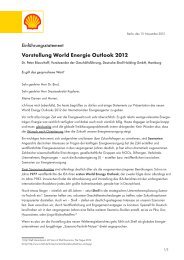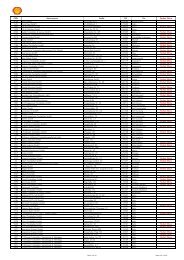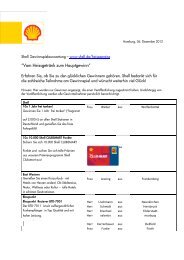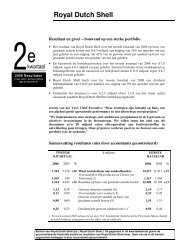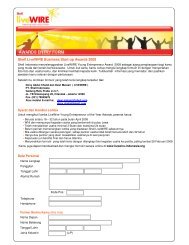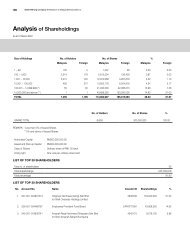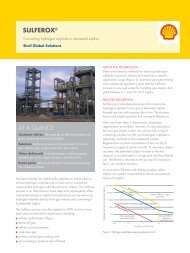ENVIRONMENTAL STATEMENT BARDOLINO DEVELOPMENT
ENVIRONMENTAL STATEMENT BARDOLINO DEVELOPMENT
ENVIRONMENTAL STATEMENT BARDOLINO DEVELOPMENT
Create successful ePaper yourself
Turn your PDF publications into a flip-book with our unique Google optimized e-Paper software.
Bardolino Development Environmental Statement<br />
(iii) it enables the remote detection of prey. Therefore excessive underwater noise<br />
has the potential to cause disturbance through interference with communication,<br />
navigation and foraging.<br />
The effects of underwater noise on marine mammals may vary depending on the received<br />
noise level, and there are several different levels of response quoted in the literature (e.g.<br />
David, 2006; Masden et al., 2006; Richardson et al., 1995):<br />
• Detection level (zone of audibility) – the noise level that the species would normally<br />
be able to detect in a quiet sea state. The zone of audibility is defined as ‘the range<br />
at which an animal can barely detect the sound source’ (Masden et al., 2006).<br />
• Avoidance level (zone of responsiveness) – the noise level at which the species<br />
would start to exhibit active avoidance behaviour, such as moving away. The zone of<br />
responsiveness is defined as ‘the zone in which the animal responds to the sound<br />
exposure either behaviourally or physiologically’ (Masden et al., 2006).<br />
It is proposed that levels of 90 dBht(species) and above would cause significant<br />
avoidance reaction, with strong avoidance by most individuals at 100 dB ht(species).<br />
Mild avoidance reaction occurs in a minority of individuals at levels above about 75<br />
dBht(species) (dBht is a measure of the level of sound above the animals hearing<br />
threshold, or its “perception level”) (Nedwell et al., 2004).<br />
• Masking level (zone of masking) – the noise level that could mask the species<br />
vocalisation (communication and echolocation signals). The zone of masking is<br />
defined as ‘the range at which the anthropogenic noise adds significant energy to the<br />
ambient noise in frequency bands that overlap with the signals of interest’ (Masden et<br />
al., 2006). Masking is predicted when noise levels are above the received<br />
vocalisation level and hearing threshold.<br />
• Temporary threshold shift (TTS) threshold – the noise level that would cause a<br />
temporary but reversible shift (change in hearing ability) in the individual’s hearing<br />
sensitivity.<br />
When an animal is exposed to a loud noise for a period of time, the acuteness of its<br />
hearing may be temporarily diminished, i.e. it may be unable to detect noise levels<br />
that it would normally be expected to hear. This phenomenon is reversible (or<br />
disappears) some time after the animal is removed from the loud noise source. In a<br />
review of threshold levels, Ketten (1998) concluded that a noise level of 140 dB, that<br />
is also 80 – 90 dB above the species hearing threshold at each frequency, is<br />
necessary to produce a significant temporary change in hearing ability.<br />
• Permanent threshold shift (PTS) – the noise level that would cause a permanent shift<br />
in the individual’s hearing sensitivity.<br />
• Physical damage level – the noise level or pressure level that would result in gross<br />
physical damage to the organism’s auditory system, other organs or tissues.<br />
The threshold peak impulse sound pressure for direct physical trauma in marine<br />
mammals is generally considered to be >200 dB (McCauley, 1994; Richardson et al.,<br />
1995; Gordon et al., 2004).<br />
Underwater noise may result in the exclusion of cetaceans from important habitats or impede<br />
reproductive and feeding patterns (Richardson et al., 1995). In addition, underwater noise<br />
also has the potential to disturb prey species. The potential effects of changes in prey<br />
availability or access to foraging areas on marine mammals is largely unknown. Most marine<br />
mammal species may be able to change their diet and feeding areas in response to shortterm<br />
changes in prey availability. However, long-term changes have the potential to affect<br />
their distribution, body condition, susceptibility to disease, exposure to contaminants,<br />
reproductive success, and survival.<br />
April 2008 Page 6-23




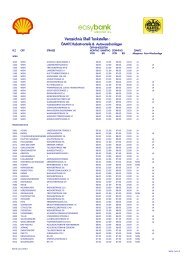
![Download Shell AutoGas Stationen [Stand: Januar 2013] (PDF](https://img.yumpu.com/9982753/1/190x245/download-shell-autogas-stationen-stand-januar-2013-pdf.jpg?quality=85)

